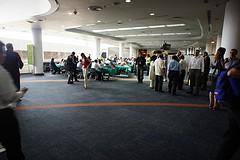Climate Conference
 This once negotiations have been blocked in connection with the protest, which expressed the African Group, blamed developed nations in the intention to 'kill' the currently existing Kyoto Protocol. Later, the conflict has been settled and Representatives of G77, which includes developing countries, have returned to negotiations. Add oil to the fire during the climate conference, and environmental activists. In Copenhagen, took a lot of protests activists who demanded that the forum participants taking climate agreement. Climate Forum brought thousands of protesters in Copenhagen.
This once negotiations have been blocked in connection with the protest, which expressed the African Group, blamed developed nations in the intention to 'kill' the currently existing Kyoto Protocol. Later, the conflict has been settled and Representatives of G77, which includes developing countries, have returned to negotiations. Add oil to the fire during the climate conference, and environmental activists. In Copenhagen, took a lot of protests activists who demanded that the forum participants taking climate agreement. Climate Forum brought thousands of protesters in Copenhagen.
Activists of youth environmental organizations have stated that they intend to surround the Bell Centre, where the un Climate Conference, and not to let out without a prime minister and president signed the climate treaty. Later, Greenpeace activists managed to break through to the gala dinner, which gave the Queen Margrethe ii of Denmark in honor of Heads of State and Government participating in the climate summit. Environmental campaigners unfurled banners with the inscription: "Politicians say – the leaders are." By the end of the second Week forum more delegates un Climate Conference in Copenhagen was inclined to believe that the best option out of the impasse that emerged at the talks will be 'zero option' – to finish the meeting without taking no decision, and to reconvene in July in Bonn. Representatives of developing countries from the G77 group also performed with the proposal not to close negotiations officially, but only to interrupt them until July and has not taken any documents. K very close climate summit all members of the international un conference on global climate change, held in Copenhagen, still reached an agreement on climate.
 The Campaign Fraternity and Land of 1986, approaches the distribution of the land in Brazil in different way, that culminated with the promulgation of the Brazilian Constitution of 1988, where in its article 5, interpolated proposition XIII, affirms: that the property takes care of the social function, and demonstrates the hour where if receives a piece from soil has been broken for preservation, it is taken care of of what he is its.
The Campaign Fraternity and Land of 1986, approaches the distribution of the land in Brazil in different way, that culminated with the promulgation of the Brazilian Constitution of 1988, where in its article 5, interpolated proposition XIII, affirms: that the property takes care of the social function, and demonstrates the hour where if receives a piece from soil has been broken for preservation, it is taken care of of what he is its.